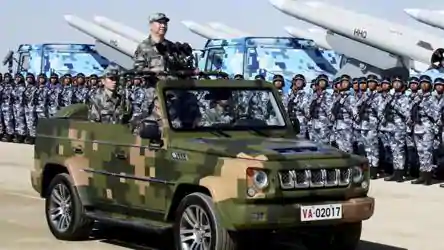
SOURCE: HT
The People’s Republic of China (PRC) will be celebrating the 93rd founding anniversary of the People’s Liberation Army (PLA) on August 1. Consolidated in 1927 during the Nanchang uprising by the Chinese Communist Party (CCP), PLA was formed as an armed wing to counter the Kuomintang’s anti-communist purges during the Chinese civil wars. Since then, PLA has become the world’s largest armed force with around 2.03 million active and 510,000 reserve personnel.
In its recent history, it had two important turning points. First, the United States (US)’ use of advanced and sophisticated weaponry in the first Gulf War of the 1990s compelled PLA to pursue technological advancement. Two, the Central Military Commission (CMC) chairman, Xi Jinping’s championing of the Chinese dream to make PLA a world-class force by 2049 led to its restructuring and rapid modernisation. However, despite the technological advances and growing military might, PLA has key weaknesses. Here are the four most important challenges for PLA at 93.
One, PLA is accused of being infected by the peace disease (Hépíng bìng), peacetime habits (Hépíng jixí) and peace problems (Hépíng jibì), as it has not participated in any war since 1979. This is a condition where a soldier’s casual peacetime approach while training could impact wartime combat readiness. CCP is concerned that PLA doesn’t understand the intensity of modern combat. Xi is aware of this and has introduced changes to PLA’s regime to make it train under “realistic combat conditions”. My research also indicates that the number of PLA’s bilateral-trilateral military exercises with the foreign armies has increased since 2014 to compensate for the lack of combat experience. But the impact of this change cannot be verified until PRC goes to war.
Two, PLA has been on a modernisation spree for the last two decades and has made notable progress since Xi took over as the CMC chairman in 2012. This is reflected in its defence budget, which allocates the most significant share of spending on capital expenditure. However, it has realised that the military modernisation doesn’t match with the quality of personnel employed, especially in the technology-centric services such as the navy, air force, rocket force and the strategic support force. Acknowledging these gaps, PLA altered its recruitment strategy by focusing on employing better-qualified students from specialised and technical universities. It felt the need to rework its conscription model to achieve the informatisation goal for the armed forces by 2035, which was announced by Xi in the 2017 party congress. To achieve this, CMC introduced several financial incentives to attract highly educated talent. However, despite positive inducements, recent reports suggest that the gap still exists and PLA is still facing a shortage of skilled expertise to drive its technology-centric services.
Three, graft in the armed forces undermines its ability on the battlefield, impacts the military’s image and hinders the development of the national defence. Corruption in PLA became widespread when it branched out into business, seeking opportunities from the new market reforms in the 1980s. The then chairman, Jiang Zemin, tried to address this problem by dissolving the military-business complex in 1998, but by then, the rot had set in too deep and had become pervasive. Xi, after becoming CCP general secretary in 2012, expanded the fight against corruption, resulting in more than 4,000 anti-graft investigations. This resulted in the sacking of high-level officers. The most notable cases were Xu Caihou and Guo Boxiong; both served as CMC vice-chairmen under former CCP general secretary Hu Jintao. But, some changes such as the introduction of the discipline inspection commissioner within CMC, dismantling the four military-bureaucratic departments and removing service chiefs from CMC developed internal resistance. There were many influential losers due to Xi’s reforms, which probably could have led to resistance within the forces. Many of the senior officers were reassigned to appropriate positions throughout the rank and files of PLA as compensation rather than being removed from duty. Although this has reduced the resistance, the effectiveness of the reforms, which were meant to reduce corruption, can be questioned.
Four, consistent military modernisation is one of the most important aspects for realising the Chinese dream of a world-class force by 2049. But increasing revenue expenditure and the cost of maintaining already commissioned weaponry could play spoiler. Of its total defence spending, China’s capital expenditure, used for military modernisation, has increased every year since 2012 and crossed the 40% mark since 2015. But notably, China also has the largest pool of 57 million PLA veterans, demanding post-retirement benefits and better retirement deals. These post-retirement wages, pensions and living subsidies are incurred from China’s defence spending. Rising revenue bills, since 2018, will certainly impact capital expenditure in the near future. Besides, PLA also has to maintain existing weaponry, which it has commissioned over the last few years. The maintenance cost for equipment and vessels, in select cases such as the navy and probably air force, is higher than the manufacturing and commissioning cost. Thus, the twin factor of rising revenue bills and increasing maintenance cost will slow China’s military modernisation drive.
Besides these four major problems, there are other operational gaps such as limited strategic airlift and open-sea refuelling capabilities, limited overseas military bases, lack of joint operations capabilities and the lack of a rotational system within the lower-ranked officers of PLA. All these limitations will not only impact the Chinese dream but also alter its capabilities to attain its strategic military guidelines in the future.






